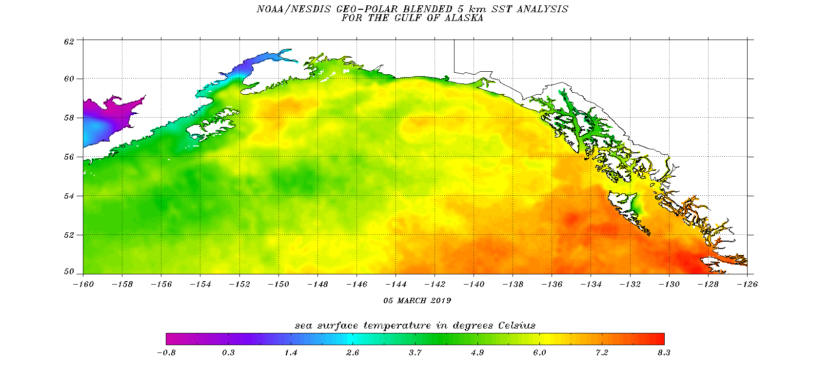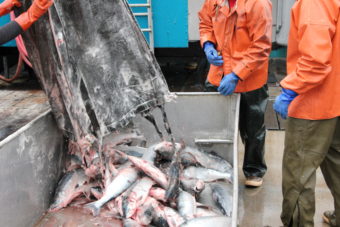
The Gulf of Alaska is once again experiencing a marine heatwave. This follows the infamous warm-water event known as “the Blob,” that formed back in 2014, which scientists have tied to seabird die-offs and declining Pacific cod stocks.
Researchers want to predict when and where the world’s oceans will heat up, but there are economic implications to forecasting the future.
Scientists around the world are working to understand the impacts of marine heatwaves as they become more common. They also want to be able to predict when the heatwaves will happen.
“If I gave you this information about the future, what would you possibly even do with it?” research scientist Alistair Hobday said. “And people’s first reaction is, ‘Nothing. I don’t know what I would do.’”
Hobday works with Australia’s Commonwealth Scientific and Industrial Research Organisation. Hobday said the predictive models for marine heatwaves are about 60 percent accurate currently, slightly better than a flip of a coin.
He wants to boost that number to 80 percent, and he said marine heatwave forecasts have practical applications.
“In Australia, we do forecasting for the salmon aquaculture industry. If you get information that there is going to be a heatwave, you might choose to harvest your fish early. You might choose to provide more oxygen directly by aerating the water so that it has more oxygen in warm water,” he explained. “You might choose to move your cages to a slightly cooler part of the coast.”
Here in Alaska, the state’s Department of Fish and Game wants to provide more predictability in one of Alaska’s most valuable fisheries. Fish and Game biologist Richard Brenner is working to use sea surface temperatures in the Gulf of Alaska to predict when sockeye salmon will return to their natal streams.
“With warmer water temperatures, sockeye salmon sometimes have a difficult time finding adequate prey items,” Brenner said. “Their range where they would they find those prey items can be restricted, and it takes them longer to feed and to sexually mature and therefore return to their natal spawning areas in Cook Inlet and elsewhere.”
Brenner said accurate run timing predictions would help Fish and Game better manage sport, subsistence and commercial harvests, but processors and fishermen may also benefit.
Nate Berga is the plant manager for Pacific Star Seafoods in Kenai. Berga explained that Pacific Star typically purchases all the packaging and equipment it needs before the season begins. It also hires roughly 250 workers that need to be fed and housed.
Run timing predictions could allow Pacific Star to purchase supplies as it needs them and hire those employees in stages, significantly reducing the upfront financial cost every season.
“You’re sitting there waiting for the fish. People get discouraged, and they may want to leave,” Berga added. “That’s happened some seasons, where crew starts to go and all of a sudden fish starts to come in late, and now you don’t have an adequate crew size to handle the volume.”
Berga added that sockeye runs in northern Cook Inlet have been returning late in recent years. Fish and Game’s work may also allow sockeye managers around the state to provide more opportunity if they know a run is late.

“I think if Fish and Game knew what was coming and felt pretty certain about that, my wish list would be that they would let us fish instead of letting all of the fish go up the river and we’re on the sideline watching that happen,” Berga said.
However, similar temperature-based forecasts have caused tension elsewhere.
Maine’s lobster fishery kicks off every summer as warmer waters cause the valuable crustaceans to molt. But a marine heatwave in 2012 caused the lobster population to shed their exoskeletons early, throwing a glut of lobster onto the market.
Annie Tselikis is the executive director of the Maine Lobster Dealers’ Association. She said the lobster supply chain wasn’t ready and prices dropped.
“So the Gulf of Maine Research Institute tried to time the molt so that they could say, ‘OK industry, this is when you should expect this product to arrive at your shores,’” she explained.
Researchers at the Gulf of Maine Research Institute thought they were providing a service to the industry, but Tselikis said grocery and restaurant wholesalers began using those predictions to haggle for lower prices.
“They just saw a report that said, ‘well the quantity is going to be high and the timing is going to be later, and so why would I buy lobster from you right now? Why wouldn’t I wait and wait for you to get me a better price?’” Tselikis explained.
After pressure from lobster dealers and fishermen, the research institute stopped publishing its work in 2017. It will be a year or more before Fish and Game decides whether it can reliably predict sockeye run timing in Cook Inlet on a day-to-day basis.
Those like Berga say the tool would benefit everyone in the sockeye industry, but he said processors and fishermen would likely wait a few years before hedging any bets on those predictions.
After all, he said, Mother Nature has been known to throw a curveball or two.
